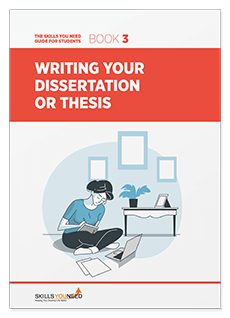Writing a Dissertation:
The Introduction
From our: Dissertation Writing guide.
The introduction to your dissertation or thesis may well be the last part that you complete, excepting perhaps the abstract. However, it should not be the last part that you think about.
You should write a draft of your introduction very early on, perhaps as early as when you submit your research proposal, to set out a broad outline of your ideas, why you want to study this area, and what you hope to explore and/or establish.
You can, and should, update your introduction several times as your ideas develop. Keeping the introduction in mind will help you to ensure that your research stays on track.
The introduction provides the rationale for your dissertation, thesis or other research project: what you are trying to answer and why it is important to do this research.
Your introduction should contain a clear statement of the research question and the aims of the research (closely related to the question).
It should also introduce and briefly review the literature on your topic to show what is already known and explain the theoretical framework. If there are theoretical debates in the literature, then the introduction is a good place for the researcher to give his or her own perspective in conjunction with the literature review section of the dissertation.
The introduction should also indicate how your piece of research will contribute to the theoretical understanding of the topic.
Drawing on your Research Proposal
The introduction to your dissertation or thesis will probably draw heavily on your research proposal.
If you haven't already written a research proposal see our page Writing a Research Proposal for some ideas.
The introduction needs to set the scene for the later work and give a broad idea of the arguments and/or research that preceded yours. It should give some idea of why you chose to study this area, giving a flavour of the literature, and what you hoped to find out.
Warning!
Don’t include too many citations in your introduction: this is your summary of why you want to study this area, and what questions you hope to address. Any citations are only to set the context, and you should leave the bulk of the literature for a later section.
Unlike your research proposal, however, you have now completed the work. This means that your introduction can be much clearer about what exactly you chose to investigate and the precise scope of your work.
Remember, whenever you actually write it, that, for the reader, the introduction is the start of the journey through your work. Although you can give a flavour of the outcomes of your research, you should not include any detailed results or conclusions.
Some good ideas for making your introduction strong include:
- An interesting opening sentence that will hold the attention of your reader.
- Don’t try to say everything in the introduction, but do outline the broad thrust of your work and argument.
- Make sure that you don’t promise anything that can’t be delivered later.
- Keep the language straightforward. Although you should do this throughout, it is especially important for the introduction.
Top Tip:
Your introduction is the reader’s ‘door’ into your thesis or dissertation. It therefore needs to make sense to the non-expert. Ask a friend to read it for you, and see if they can understand it easily.
At the end of the introduction, it is also usual to set out an outline of the rest of the dissertation.
This can be as simple as ‘Chapter 2 discusses my chosen methodology, Chapter 3 sets out my results, and Chapter 4 discusses the results and draws conclusions’.
However, if your thesis is ordered by themes, then a more complex outline may be necessary.
Drafting and Redrafting
As with any other piece of writing, redrafting and editing will improve your text.
This is especially important for the introduction because it needs to hold your reader’s attention and lead them into your research.
The best way to ensure that you can do this is to give yourself enough time to write a really good introduction, including several redrafts.
Do not view the introduction as a last minute job.

